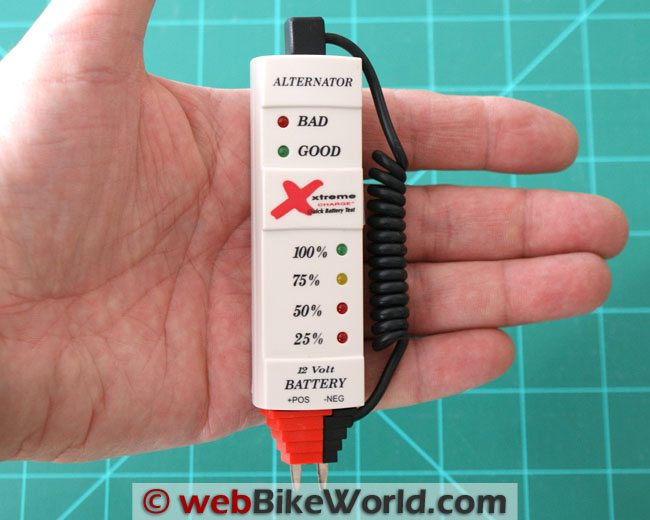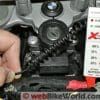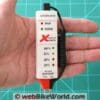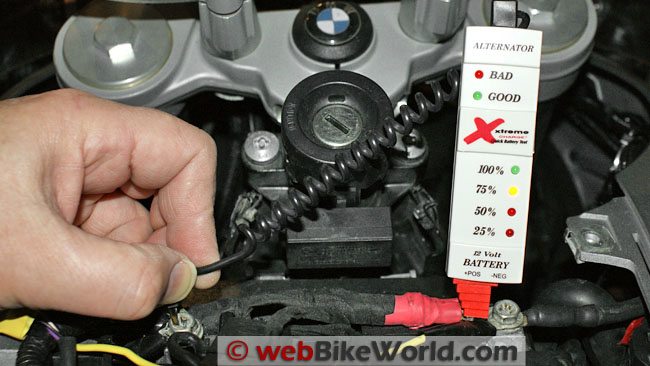For most of us simple is good and simply functional even better.
In this regard the very portable PulseTech Xtreme Charge Quick Battery and Alternator test device makes perfect sense. My advice: get one, keep it close and use it.
When we purchased the product, it was known as the XC 822-TEST, PulseTech Xtreme Charge Quick Battery Test. It is now known as the XC 820-TEST, the PulseTech Xtreme Charge Alternator Quick Tester.
Without wanting to sound like a well-worn recording, it is worth repeating that the health of a motorcycle battery is critical, along with the rest of the electrical system.
But many of us don’t undertake even the most basic electrical care-giver tasks and even if we have the basic assessment tools, and the knowledge to use them, we don’t.
Battery maintenance should be an ongoing activity; especially so as temperatures “fall” towards winter and longer periods of inactivity loom as a reality for many of our favourite two-wheeled steeds.
Timing is everything and I now have four battery charging products (a locally purchased CTEK US 3300, a SolarPulse SP-5 and Optimate 4 (review) forwarded by the Editor, along with my faithful BMW Charger) in steady or rotational use between the various motorcycles in the family fleet.
And while these smart devices, less the SolarPulse, can assess and visually signal the condition of a battery within seconds or a few minutes, a small portable testing device is always good to have at hand to provide a quick initial assessment, especially if AC power is not readily available.
I was long overdue in getting a simple tester that didn’t necessitate digging out and using my small portable multimeter that is kept packed in the “essential tools” bag.
But almost hidden away in the box of chargers received from the Editor was exactly what I needed: the PulseTech Xtreme Charge Quick Battery and Alternator tester.
Form, Fit and Function
Marketed by PulseTech Products Corporation under the Xtreme Charge product line (XC 822-TEST), the palm-sized self-contained tester measures 5 in long x 1.5 in wide and 5/8 in thick and weighs in at around 1.0 oz. (30 g).
This small size means it is easily carried in a small pocket or stash pouch of a tank-bag or riding gear.
The negative and positive probe moldings fit together forming a pyramid shape at one end of the device. As the positive (Red) probe is fixed in place, the negative (Black) probe has a flex coil lead secured to the other end of the unit.
This lead can be stretched out comfortably about eight to ten inches.
A dual purpose device, the PulseTech Xtreme Battery Tester can provide a basic assessment of any alternator condition and a slightly more detailed four-level evaluation of a battery.
The assessments are visually indicated by clearly labeled coloured LEDs that make for easy reading, even in low light conditions.
Given its duality of use, the face of the device (probes facing down) is marked in two sections delineated by a product logo.
The upper section is the Alternator test section — its two LEDs indicate either BAD or GOOD. The lower section is for the Battery test — four coloured LEDS indicate 100, 75, 50 and 25 percent top to bottom.
The voltage range for each percentile assessment is 25% = 9.8 to 12.0V; 50% = 12.0 to 12.4V; 75% = 12.4 to 12.6V; and 100% = 12.6 to 13.8V.
Using the Tester
To use the device, simply pull the negative probe away from its positive mate. Touch the Red probe to the positive terminal or connection lead of a 12V battery and extend the negative probe to the negative terminal or connection point.
For a battery test, the engine is off. Once the connections are made and a circuit completed, one of the four Battery LEDs will light up, indicating the assessed charge level by percentile.
The pin-style probes will make connecting to virtually any point quite simple, including SAE leads or multi-pin connectors.
A more in-depth battery test can be done as well for comparison or monitoring purposes.
Leave the engine off, switch on the ignition and let the battery discharge for a few minutes, switch off the ignition and disconnect the battery from the motorcycle’s electrical system, then make the test connection.
The alternator test is performed with the engine running. With the positive and then negative connections made, the device will indicate a reading via the Alternator LEDs. If the “Good” LED lights up (13.8 to 14.7V), all is fine.
The “Bad” LED indicates the alternator is overcharging (14.7V and up). If neither LED lights up, the alternator is undercharging.
Just remember that the tester is a simple open circuit voltage meter meant to be used for quick assessments or to indicate basic faults in the charging system. It is not intended to be used for in-depth diagnostics.
Conclusion
Between the multiple motorcycles, and therefore multiple batteries sitting out in the garage, the PulseTech Xtreme Charge Quick Battery Test device lets me to do a quick initial assessment on a battery and then on a regular basis for tracking purposes.
The device is simple, easy to carry, and easy to use. For home or away, this is one handy tool that is staying close at hand.
wBW Motorcycle Battery & Charger Reviews | Maintenance & Repair Articles
|
wBW Product Review: PulseTech Xtreme Battery and Alternator Tester
|
|
|---|---|
| Manufacturer: PulseTech | List Price (2010): $12.95 |
| Colour: White | Made In: China |
| Review Date: November 2010. Notes: Warranty is 90 days. | |
Owner Comments and Feedback
See details on submitting comments.
From “X” (11/10): “The caveat that this product is meant to indicate basic faults in the system could be more greatly emphasized.
My bike currently has a fault in the charging system where one of the diodes in the regulator or rectifier has failed -reaching maybe 13.4V tops at the battery at normal revs — which this device would imply is an alternator defect.
It’s probably a good pass/fail test for the charging system as a whole, but calling it an “alternator tester” is misleading.”
From “N.G.” (11/10): “That battery tester does not seem very useful. From the description, it’s just a Volt meter, but you can only use it when you’re stopped and have access to the battery.
What would be more useful is a battery gauge / volt meter that is installed in the dashboard and permanently hooked up to the battery.
That way, you can easily tell if you’re over-taxing the capacity of your alternator, for example, by drawing too much current with heated clothing etc.
It also lets you know instantly when something goes wrong with the connectors and wires in the battery charging system.
I once had a problem with a bad connector that would loosen from vibrations and left me stranded when the battery became completely discharged as a result. Now I have 2 battery gauges in the dashboard of my DRZ-400.
One would be sufficient, the second one is for paranoia. This Kuryakyn LED Battery Gauge works well and is very small.
The Datel digital Volt meter is the smallest that I’ve found that displays voltage as a number.”






